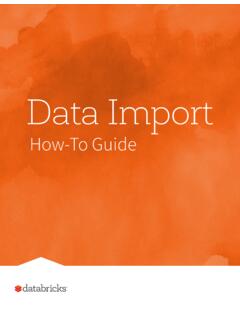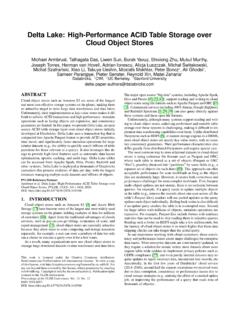Transcription of EBOOK The Big Book of Data Engineering
1 EBOOKThe Big Book of Data EngineeringA collection of technical blogs, including code samples and Real-Time Point-of-Sale Analytics With the Data Lakehouse .. Building a Cybersecurity Lakehouse for CrowdStrike Falcon Events .. Unlocking the Power of Health Data With a Modern Data Lakehouse .. Timeliness and Reliability in the Transmission of Regulatory AML Solutions at Scale Using Databricks Lakehouse Platform .. Build a Real-Time AI Model to Detect Toxic Behavior in Gaming .. Driving Transformation at Northwestern Mutual (Insights Platform) by Moving Toward a Scalable, Open Lakehouse Architecture .. How Databricks Data Team Built a Lakehouse Across Three Clouds and 50+ Regions .. Atlassian .. ABN AMRO .. Hunt .. 56 Introduction to Data Engineering on Databricks .. 3 Real-Life Use Cases on the Databricks Lakehouse Platform .. 8 Customer Stories.
2 51 SECTION 1 SECTION 2 SECTION 32 The Big Book of Data Engineering01 SECTIONI ntroduction to Data Engineering on DatabricksOrganizations realize the value data plays as a strategic asset for various business-related initiatives, such as growing revenues, improving the customer experience, operating efficiently or improving a product or service. However, accessing and managing data for these initiatives has become increasingly complex. Most of the complexity has arisen with the explosion of data volumes and data types, with organizations amassing an estimated 80% of data in unstructured and semi-structured format. As the collection of data continues to increase, 73% of the data goes unused for analytics or decision-making. In order to try and decrease this percentage and make more data usable, data Engineering teams are responsible for building data pipelines to efficiently and reliably deliver data. But the process of building these complex data pipelines comes with a number of difficulties: In order to get data into a data lake, data engineers are required to spend immense time hand-coding repetitive data ingestion tasks Since data platforms continuously change, data engineers spend time building and maintaining, and then rebuilding, complex scalable infrastructure With the increasing importance of real-time data, low latency data pipelines are required, which are even more difficult to build and maintain Finally, with all pipelines written, data engineers need to constantly focus on performance, tuning pipelines and architectures to meet SLAs How can Databricks help?
3 With the Databricks Lakehouse Platform, data engineers have access to an end-to-end data Engineering solution for ingesting, transforming, processing, scheduling and delivering data. The Lakehouse Platform automates the complexity of building and maintaining pipelines and running ETL workloads directly on a data lake so data engineers can focus on quality and reliability to drive valuable 1 The Databricks Lakehouse Platform unifies your data, analytics and AI on one common platform for all your data use casesThe data lakehouse is the foundation for data Engineering SIMPLE OPEN COLLABORATIVEL akehouse PlatformData EngineeringData Management and GovernmentOpen Data LakeBI and SQL AnalyticsReal-Time Data ApplicationsData Science and ML4 The Big Book of Data EngineeringKey differentiators for successful data Engineering with Databricks By simplifying on a lakehouse architecture, data engineers need an enterprise-grade and enterprise-ready approach to building data pipelines.
4 To be successful, a data Engineering solution team must embrace these eight key differentiating capabilities: Continuous or scheduled data ingestion With the ability to ingest petabytes of data with auto-evolving schemas, data engineers can deliver fast, reliable, scalable and automatic data for analytics, data science or machine learning. This includes: Incrementally and efficiently processing data as it arrives from files or streaming sources like Kafka, DBMS and NoSQL Automatically inferring schema and detecting column changes for structured and unstructured data formats Automatically and efficiently tracking data as it arrives with no manual intervention Preventing data loss by rescuing data columns Declarative ETL pipelines Data engineers can reduce development time and effort and instead focus on implementing business logic and data quality checks within the data pipeline using SQL or Python.
5 This can be achieved by: Using intent-driven declarative development to simplify how and define what to solve Automatically creating high-quality lineage and managing table dependencies across the data pipeline Automatically checking for missing dependencies or syntax errors, and managing data pipeline recovery Data quality validation and monitoring Improve data reliability throughout the data lakehouse so data teams can confidently trust the information for downstream initiatives by: Defining data quality and integrity controls within the pipeline with defined data expectations Addressing data quality errors with predefined policies (fail, drop, alert, quarantine) Leveraging the data quality metrics that are captured, tracked and reported for the entire data pipeline 5 The Big Book of Data EngineeringFault tolerant and automatic recovery Handle transient errors and recover from most common error conditions occurring during the operation of a pipeline with fast, scalable automatic recovery that includes.
6 Fault tolerant mechanisms to consistently recover the state of data The ability to automatically track progress from the source with checkpointing The ability to automatically recover and restore the data pipeline state Data pipeline observability Monitor overall data pipeline status from a dataflow graph dashboard and visually track end-to-end pipeline health for performance, quality and latency. Data pipeline observability capabilities include: A high-quality, high-fidelity lineage diagram that provides visibility into how data flows for impact analysis Granular logging with performance and status of the data pipeline at a row level Continuous monitoring of data pipeline jobs to ensure continued operation Batch and stream data processing Allow data engineers to tune data latency with cost controls without the need to know complex stream processing or implement recovery logic. Execute data pipeline workloads on automatically provisioned elastic Apache Spark -based compute clusters for scale and performance Use performance optimization clusters that parallelize jobs and minimize data movement Automatic deployments and operations Ensure reliable and predictable delivery of data for analytics and machine learning use cases by enabling easy and automatic data pipeline deployments and rollbacks to minimize downtime.
7 Benefits include: Complete, parameterized and automated deployment for the continuous delivery of data End-to-end orchestration, testing and monitoring of data pipeline deployment across all major cloud providers Scheduled pipelines and workflows Simple, clear and reliable orchestration of data processing tasks for data and machine learning pipelines with the ability to run multiple non-interactive tasks as a directed acyclic graph (DAG) on a Databricks compute cluster. Easily orchestrate tasks in a DAG using the Databricks UI and API Create and manage multiple tasks in jobs via UI or API and features, such as email alerts for monitoring Orchestrate any task that has an API outside of Databricks and across all clouds 6 The Big Book of Data EngineeringData Sources DatabasesStreaming SourcesCloud Object StoresSaaS ApplicationsNoSQLOn-Premises SystermsData Consumers BI/Reporting DashboardingMachine Learning/Data ScienceObservability, lineage and end-to-end data pipeline visibilityOpen format storageAutomated data pipeline deployment and operationalizationData transformation and qualityScheduling and orchestrationContinuous or batch data processingData Engineering on the Databricks Lakehouse PlatformData ingestionConclusion As organizations strive to become data-driven, data Engineering is a focal point for success.
8 To deliver reliable, trustworthy data, data engineers shouldn t need to spend time manually developing and maintaining an end-to-end ETL lifecycle. Data Engineering teams need an efficient, scalable way to simplify ETL development, improve data reliability and manage described, the eight key differentiating capabilities simplify the management of the ETL lifecycle by automating and maintaining all data dependencies, leveraging built-in quality controls with monitoring and providing deep visibility into pipeline operations with automatic recovery. Data Engineering teams can now focus on easily and rapidly building reliable end-to-end production-ready data pipelines using only SQL or Python for batch and streaming that delivers high-value data for analytics, data science or machine learning. Use cases In the next section, we describe best practices for data Engineering end-to-end use cases drawn from real-world examples.
9 From data ingestion and data processing to analytics and machine learning, you ll learn how to translate raw data into actionable data. We ll arm you with the data sets and code samples, so you can get your hands dirty as you explore all aspects of the data lifecycle on the Databricks Lakehouse 2 Data Engineering on Databricks reference architecture7 The Big Book of Data Engineering02 SECTIONReal-Life Use Cases on the Databricks Lakehouse PlatformReal-Time Point-of-Sale Analytics With the Data LakehouseBuilding a Cybersecurity Lakehouse for CrowdStrike Falcon EventsUnlocking the Power of Health Data With a Modern Data LakehouseTimeliness and Reliability in the Transmission of Regulatory ReportsAML Solutions at Scale Using Databricks Lakehouse PlatformBuild a Real-Time AI Model to Detect Toxic Behavior in Gaming Driving Transformation at Northwestern Mutual (Insights Platform) by Moving Toward a Scalable, Open Lakehouse ArchitectureHow Databricks Data Team Built a Lakehouse Across Three Clouds and 50+ RegionsDisruptions in the supply chain from reduced product supply and diminished warehouse capacity coupled with rapidly shifting consumer expectations for seamless omnichannel experiences are driving retailers to rethink how they use data to manage their operations.
10 Prior to the pandemic, 71% of retailers named lack of real-time visibility into inventory as a top obstacle to achieving their omnichannel goals. The pandemic only increased demand for integrated online and in-store experiences, placing even more pressure on retailers to present accurate product availability and manage order changes on the fly. Better access to real-time information is the key to meeting consumer demands in the new this blog, we ll address the need for real-time data in retail, and how to overcome the challenges of moving real-time streaming of point-of-sale data at scale with a data lakehouse. The point-of-sale systemThe point-of-sale (POS) system has long been the central piece of in-store infrastructure, recording the exchange of goods and services between retailer and customer. To sustain this exchange, the POS typically tracks product inventories and facilitates replenishment as unit counts dip below critical levels.











